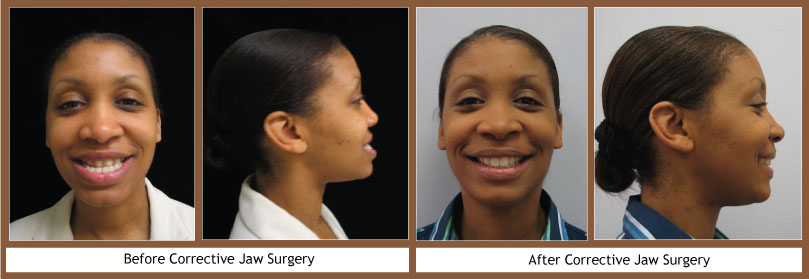Orthognathic Surgery, known as Corrective Jaw Surgery corrects minor and major dental and skeletal abnormalities. Corrective jaw surgery includes the correction of misaligned upper and lower jaws and teeth, and sometimes the chin, which will improve speaking, chewing, and breathing. The primary goal is to correct your functional problems, but this procedure can also dramatically enhance your appearance.


What Conditions May Require Corrective Jaw Surgery?
- Chronic jaw joint or jaw pain and headaches
- Open bite (a space between your upper and lower teeth when your mouth is closed)
- Birth defects or facial injury
- Unable to make lips touch without strain
- Difficulty biting and chewing food
- Difficulty swallowing
- Sleep apnea (unable to breathe properly while sleeping, including snoring)
- Facial appearance is unbalanced from the front or side
- Chronic dry mouth and mouth breathing
- Excessive teeth wear
- Protruding jaw
- Receding chin

Figure 1 (Left): Lower jaw is protruding out causing an underbite.(Right): The bone in the rear portion of the jaw is separated and the front is repositioned back. Figure 2 (Left): Upper jaw is protruding out causing an overbite.(Right): The bone in the front portion of the jaw is separated and the front is repositioned forward.
What Causes Jaw Misalignment?
How Do I Know if I Need Corrective Jaw Surgery?
A team approach involving your Oral Surgery Specialist, Dentist and Orthodontist will determine whether you need corrective jaw surgery. We will determine which procedure will correct your problem. Your treatment will likely include orthodontics before and after corrective jaw surgery, which can take several years to finish. Your Oral Surgeon, along with your Orthodontist and Dentist will determine the course of treatment that best suits your needs.
What is the Treatment Plan for Corrective Jaw Surgery?
Orthodontic Braces: Prior to surgery, you will need to wear braces that will move your teeth into a new position. Since your bite is being prepared so your teeth fit together after surgery, you may think that your teeth don’t fit together properly and your mouth is getting worse. However, when your jaw is repositioned, your teeth should fit well together. Closer to surgery, we will take additional x-rays and models of your teeth to ensure that your teeth will be properly aligned during surgery.
Corrective Jaw Surgery:This procedure can be performed under general anesthesia and can take anywhere from one to several hours to finish. Your jaw will be repositioned to suit your specific needs. Bone may be added, reshaped, or taken away. You also may require screws, surgical plates, rubber bands and wires to secure your jaws in their new locations. Usually, incisions are made inside your mouth to reduce noticeable scarring. Some cases require small incisions on the outside of the mouth. We will minimize the appearance if these incisions are necessary.
After Surgery:You will be instructed to modify your diet, which could include liquids and solids, with a schedule for changing over to a normal diet. You should also avoid using tobacco products and engaging in strenuous physical activity. Pain after your corrective jaw surgery can be easily managed with medication and you will be able to return to school or work between one and three weeks after surgery. Initial healing takes about six weeks, while total healing of the jaw takes approximately nine to twelve months.
What are the Benefits of Corrective Jaw Surgery?
By undergoing corrective jaw surgery, your teeth are repositioned in a more functional, balanced and healthy manner. Some patients experience drastic enhancements to their appearance and speech.
